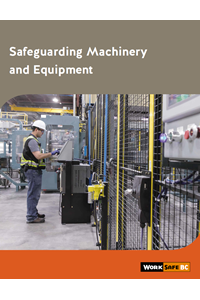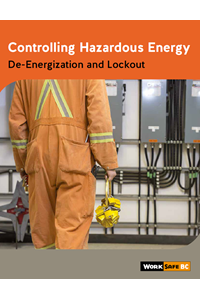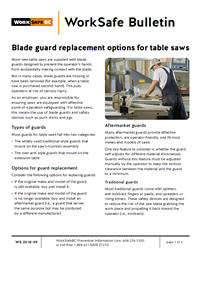Safeguarding
Safeguarding measures protect workers against contact with hazardous moving parts or other harmful conditions when working around machinery and equipment. Safeguards include barrier guards, safety devices, shields, awareness barriers, and warning signs. These methods can be used on their own or in combination to protect workers from hazards.
- Hazards
- Risk
- Hierarchy of controls
- Resources
Hazards
A safeguard is solution or a combination of solutions that eliminate or reduce the risk of exposure to hazardous moving parts or other harmful conditions. Things that put workers at risk of injury when working around machinery include:
- Rotating parts found on shafts, couplings, feed rolls, and V-belts
- Reciprocating or sliding parts such as dies in punch presses
- Parts that fragment or rupture such as abrasive wheels
- Toxic or corrosive chemicals
- Heat, noise, and vibration
- Non-ionizing radiation such as ultraviolet (UV) light
Risk
A safeguard is solution or a combination of solutions that eliminate or reduce the risk of exposure to hazardous moving parts or other harmful conditions.
"Risk" means "a chance of injury or occupational disease." The three most important factors that affect risk are severity, exposure, and probability:
- Severity — If an incident occurred, how serious would the injury be?
- Exposure — What is the extent of the workers' exposure to the hazard?
- Probability — How likely is it that an incident will occur?
Hierarchy of controls
When selecting a safeguard or a combination of safeguards, always follow the hierarchy of controls from most effective to least effective measures. Start with elimination or substitution to control the hazards. Only consider subsequent safeguards when the more effective solutions are impracticable.
-
1
Elimination or substitution
- Eliminate human interaction in the process.
- Eliminate pinch points.
- Automate materials handling.
-
2
Engineering controls
- Install mechanical hard stops.
- Install barrier guards.
- Install interlocked guards.
- Install two-hand controls.
- Install presence-sensing devices.
-
3
Administrative controls
- Develop and implement safe work procedures, including lockout procedures.
- Carry out regular inspections of safety equipment.
- Install warning devices such as lights, beacons, strobes, horns, sirens, or computer warnings.
- Paint restricted-space markings on floors or post warning signs and labels.
- Train workers.
-
4
Personal protective equipment (PPE)
Make sure workers are equipped with and use appropriate PPE such as:
- Safety eyewear
- Face shields
- Hearing protection
- Gloves



